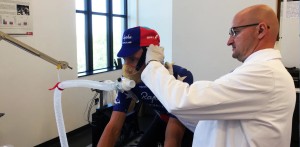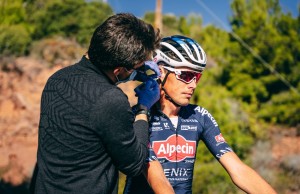The measurement of lactate during a race will be a radical change for cycling
First it was the heart rate, later it evolved towards power meters. The next step in improving performance for cyclists could be lactate monitors that would inform the cyclist in real time of the blood concentration of this substance whose excessive accumulation is the main responsible for the drop in performance.

A new revolution in cycling training is coming
When muscles oxidize glycogen to obtain energy, lactate is generated as a waste substance which, in turn, is recycled by the muscles to obtain more energy. If the intensity of pedaling is sustainable, the concentration of this substance remains stable since the muscles are capable of recycling lactate at the same rate as they generate it.
However, when the intensity increases above a certain point, the blood concentration of this substance skyrockets, reaching a point where its accumulation becomes a limit for muscle activity that forces the cyclist to reduce the intensity. That is why, for years, cyclists have undergone lactate tests with which they tried to accurately determine from what intensity this skyrocketed.
RECOMENDADO

When do helmets have to be changed? Do they have an expiration date?

Some reasons to stay away from the road in winter

The best apps for cycling and mountain biking

Black Friday 2025 cycling bargains: save on Garmin, POC, Maxxis and more

Black Friday Garmin 2025: the ultimate guide to choosing your GPS at the best price

Do you need suspension on your gravel bike?
A test that is somewhat laborious since it involves taking a blood sample, usually from the earlobe, quickly after making an effort to prevent the concentration from dropping and falsifying the measure. A sample that is analyzed at the moment and through which the coach can establish with total precision the different levels of intensity relating them, in the past with a pulse and, currently, with watts.

Now, the revolution is being proposed with several companies trying to develop a real-time lactate monitor similar to the blood glucose meters that inform the cyclist of this parameter constantly allowing him to precisely adjust his diet on route to avoid the dreaded bonk. A device that, by the way, the UCI prohibits using in competition as cyclist Kristen Faulkner found out when she lost her third place on the podium at the last Strade Bianche after using one of these meters during the race.
Perhaps this is the same problem that a lactate meter would have to face although, of course, nothing would prevent the cyclist from using it in their training to achieve even more precise intensity adjustment than what is achieved through the power meter.
And the fact is, although watts are a tremendously accurate measurement of the effort the cyclist is making, physiologically the power applied does not always correspond with the body's response to that effort. Precisely, with the lactate meter, the cyclist could know in real time how his body responds to each effort, knowing exactly if that day he can maintain 10 W more on a climb or, on the contrary, that day he has to lower his interval expectations.

Some reputable coaches like Iñigo San Millán, coach of Tadej Pogacar, define lactate meters as “the most important revolution since the invention of heart rate monitors 40 years ago”. In fact, there are cyclists who during their training stop to take lactate measurements precisely to achieve a better adjustment of that day's session as some like AG2R cyclist Larry Warbasse acknowledge.
In any case, we will still have to wait a while to have these meters that, as we said several brands and laboratories, are developing in search of taking the cyclist's training to a new level.